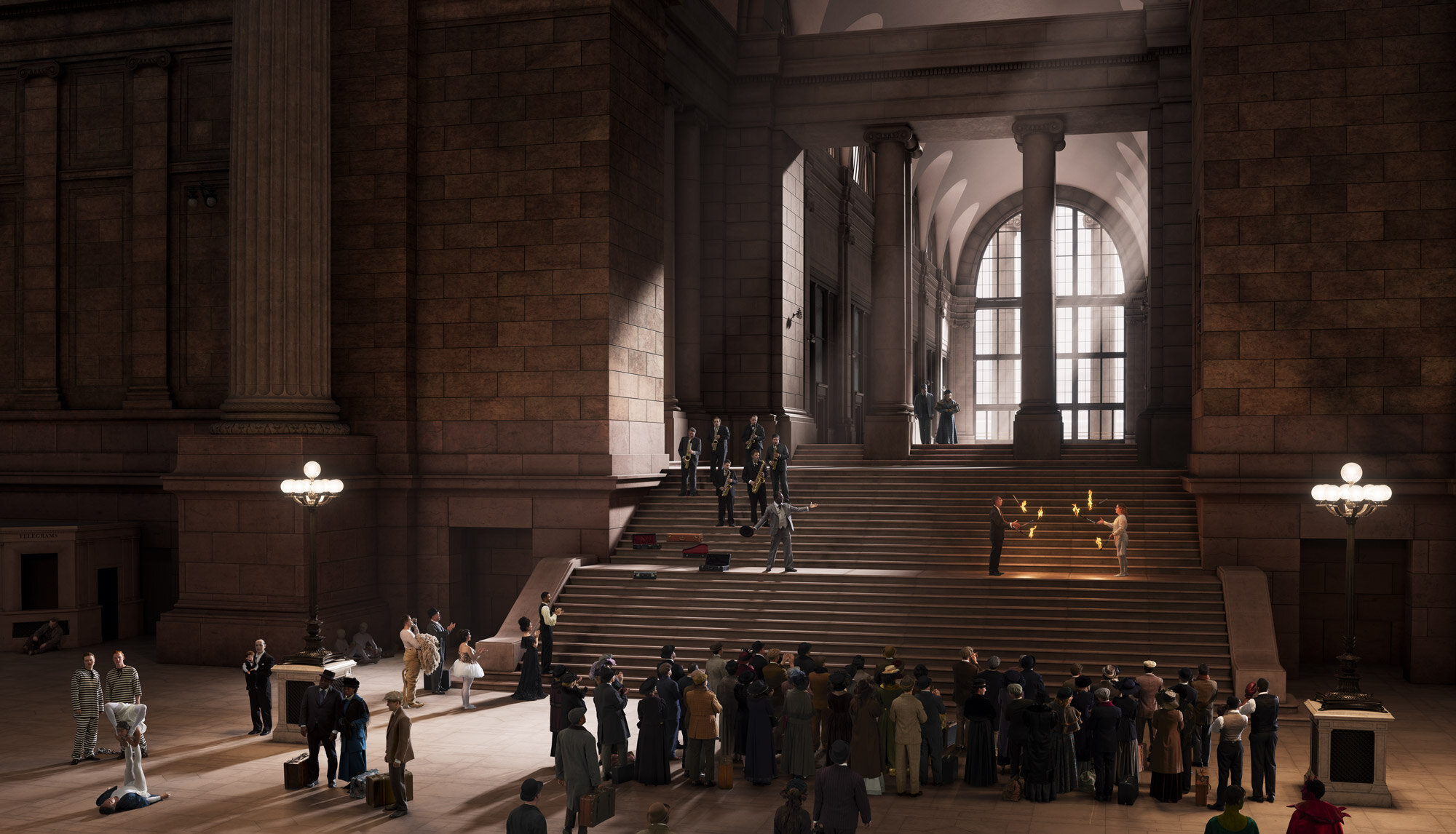Public Artworks Illuminate Moynihan Train Hall
1 March 1914, 6' 1” H x 10' 8 ½” W x ½” D, (panel 1-1) © Stan Douglas
By Micaela Bahn
Here is an unfamiliar image of Pennsylvania Station: creamy travertine walls, a concourse longer than the nave of St. Peter’s in Rome, and an iron and glass skylit waiting room that welcomed newcomers to the modern metropolis of the 20th century. This is not the gateway to New York that most are familiar with, because by the mid-1950s the original Penn Station was hemorrhaging money and the Beaux Arts masterpiece was razed. Commuter trains still ran through midtown, but they emerged in the derelict, subterranean maze that we know today. The history is quintessentially New York and exemplifies an enduring city that constantly reinvents itself. When I walked into the new Moynihan Train Hall that opened on January 1 this year, that same rousing New York quality of regeneration rippled through the air.
2 March 1914 from the series Penn Station’s Half Century, 2020Ceramic inkon glass6' 1” H x 10' 8 ½” W x ½” D, (panel 2-1 ) © Stan Douglas
The extension of the nation’s busiest transportation hub recalls traces of Penn Station’s past. Sunlight pours down onto a marble entry hall from the lofty 92-foot-high glass ceiling, steel beams arch overhead, and three site-specific instillations by Stan Douglas, Kehinde Wiley, and artist duo Emelgreen and Dragest can be glimpsed throughout the building. The dazzling series of public artworks capture the City’s creativity and layered heritage. And while this train hall cathedral does not rectify the issues plaguing its partner station, it does offer New Yorkers a glimpse at a brighter future.
20 June 1944, 6' 1” H x 7' 11/16”W x ½” D, (panel 2-3) © Stan Douglas
Just as the site itself bears vestiges of its earlier form, artist Stan Douglas’ photographic contributions function like a palimpsest of forgotten histories from the original station. The panel of 9 images, titled Penn Station’s Half Century, stand tall above wave-like seating alcoves and are speckled with figures and scenes that implore the viewer to step closer. Behind the shimmering glass you discover the soundstage from Judy Garland’s 1944 love story, The Clock. The vacant set is populated solely by props and technicians. Douglas’ own process mirrors the film’s use of artifice to recreate the nostalgic romance associated with the station.
Farther down, Douglas taps into the prominent place the station once held in the American imagination with an image of WW2 soldiers bidding farewell to loved ones before deployment. This tender scene and others like it are reconstructions, drawn from archival research, and set in the digitally recreated interiors of the demolished station.
20 June 1957, 6' 1” H x 7' 11/16” W x ½” D, (panel 3-3), © Stan Douglas
But the photograph that I could not stop searching was in panel 1 – a darkened scene on the main concourse where shafts of moonlight spill down onto a small group of motley patrons. The photograph is of a night in 1914, when a troop of vaudeville performers were stranded in the station during a snowstorm. Bert Williams – the first Black director of a motion picture – recognized the opportunity and instigated an impromptu show for his fellow travelers. Douglas’ eye for moments of serendipity and poignancy are at once individual and representative of daily life in New York’s civic spaces. The images are a salve for our current state of disconnect, as he lifts a mirror to the City and reflects the connections we have always found with strangers.
The two other commissions also evoke a sense of collective pride. Illuminated stained glass frescos by Wiley use the movements of breakdance, which originated in the Bronx, to create an allegory of human expression. If you happen to glance up at the building’s 31st street entrance, you will see Emelgreen and Dragest’s illuminated skyscrapers that descend from the ceiling. The imagined cityscape is a combination of the artists’ own invention and iconic high-rises from around the world.
22 April 1924 and 7 August 1934, from Penn Station’s Half Century, 2020, Ceramic ink on glass. One of nine photographic panels from Penn Station’s Half Century, Commissioned by Empire State Development in partnership with Public Art Fund for Moynihan Train Hall, © Stan Douglas. Courtesy of the artist, Victoria Miro and David Zwirner., Photo: Nicholas Knight, courtesy Empire State Development and Public Art Fund, NY
Commissioned by New York’s Public Art Fund, these disparate works provide artistic definition to the character of Moynihan Train Hall. Penn Station has been one of our most notorious gateways for the last 57 years and an embodiment of our cramped city. The new station and public works are a testament to New York’s resilience.












